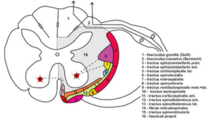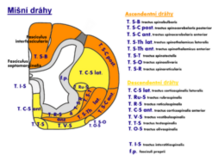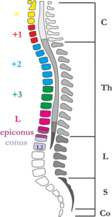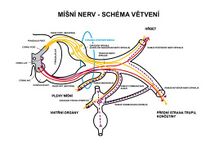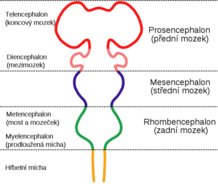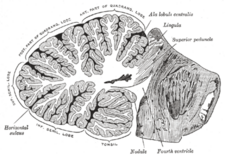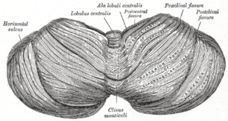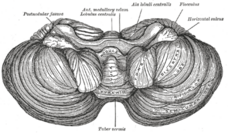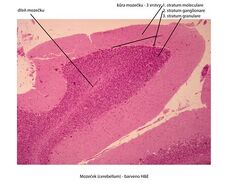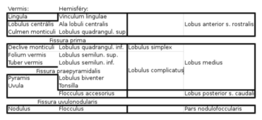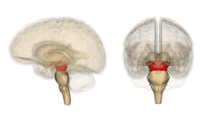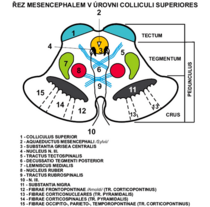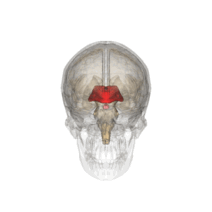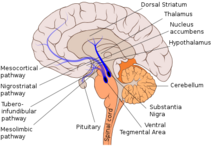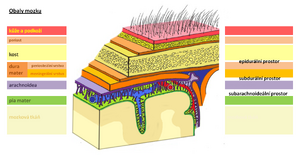Central nervous system
Medulla spinalis (spinal cord)[edit | edit source]
The spinal cord forms the center for simple reflexes. It runs through the spinal canal at the height of C1 – L2 (length 40–50 cm) and is covered with spinal cord envelopes. It performs reflex and transfer functions. The anterior and posterior spinal roots emerge from it, which subsequently join into a nerve bundle. The spinal cord contains mixed fibers (motor and sensitive) and vegetative fibers.
Anatomie míchy
At height C2 – T2 there is coarsening - intumescentia cervicalis and at height T12 – L1 intumescentia lumbosacralis.
The spinal cord is divided into spinal segments. The spinal segment is a section of the spinal cord from which 1 pair of spinal nerves converge (a total of 31 pairs of spinal nerves - 8 cervical, 12 thoracic, 5 lumbar, 5 sacral, 1 1 coccyx). It caudally tapers to a conus medullaris, the tip of which extends into L1 – L2 and then continues as a bundle of nerves, which we call the cauda equina.
Spinal mass structure
White matter
- Funiculus lateralis, anterior and posterior - cords in which nerve fibers lead up and down.
- Fissura mediana anterior - anterior notch between the anterior corners.
- Sulcus medianus posterior (posterior notch).
- Sulcus anterolateralis - fibers of the anterior spinal roots protrude from it.
- Sulcus posterolateralis - output of posterior spinal roots.
The spinal ganglion node is located on the posterior spinal cord (envelops the bodies of sensitive neurons).
Gray matter
Arranged in an H-shape, formed by an accumulation of neurons, it forms the anterior and posterior horns of the spinal cord. The lateral corners of the spinal cord form columnae anteriores, laterales and posteriores (the anterior contain motoneurons, lateral vegetative neurons, posterior connecting neurons). The spinal canal - canalis centralis - runs through the center.
Spinal reflexes
Spinal reflexes can occur at the spinal cord level. The spinal cord ensures the emptying of the bladder and rectum. The anatomical basis of the reflex is the reflex arc. The spinal cord is subordinate in its activity to the brain, it is the lowest reflex center of development, its interruption means failure of reflexes.
5 components:
- receptor, sensor;
- sensory neuron (sensitive);
- CNS;
- motor neuron (motor);
- effector(muscle).
Spinal roots
The root fibers, fila radicularia ventralia, originate from the sulcus ventrolateralis and connect to the anterior spinal roots - radices anteriores. The fila radicularia dorsalia protrudes from the dorsal part of the spinal cord and joins the posterior spinal roots - radices dorsales. The roots enter the intervertebral foramen and join the spinal nerve.
The anterior roots of the spinal cord lead to centrifugal fibers, the posterior roots of the spinal cord to centric fibers. In terms of function, the anterior spinal roots are motor and the posterior spinal roots are sensitive.
Spinal nerves
Plexus cervicalis (C1 – C4) - sensitively innervates the scalp and supra-gland area, motorically innervates the neck muscles (for example n. phrenicus).
Plexus Brachialis (C4 – Th1) - innervation of the upper limb (for example radial nerve, ulnar nerve).
Thoracic nerves - passes inside the intercostal spaces, does not form any braids. They innervate the chest wall.
Plexus lumbalis (L1 – L5) - innervation of the skin and muscles of the abdomen, thighs and pelvis.
Plexus sacralis (S1 – S5) - innervates the back of the thigh, buttocks, leg and foot. The thickest nerve in the human n. ischiadicus belongs to this plexus.
Hindbrain (rhombencephalon)[edit | edit source]
The hindbrain, rhombencephalon, consists of the following parts: myelencephalon (medulla oblongata) and metencephalon (ie Varol's bridge and cerebellum).
Medulla oblongata
Part of the hindbrain and brainstem connects to the spinal cord, 2 cm long, passes through a large occipital opening. It has anterior median fissure in the front and pyramids on the sides.
- Sulcus anterolateralis - next to the pyramids, XII. cranial nerve - nervus hypoglopus (sublingual).
- Olives - bodies lying on the sides of the medulla oblongata.
- Sulcus posterolateralis - output IX., X. and XI. cranial nerves.
- Structure: gray matter (forms nuclei - huge number, grouping of neurons); white matter (nerve fibers).
Varoli Bridge (pons Varoli)
Follows the medulla oblongata. White matter represents passing paths, gray forms nuclei. Output V. –VIII. cranial nerves. Together with the medulla oblongata, it forms the base of the fourth ventricle.
Reticular formation
a formation that penetrates the medulla oblongata and the Varol Bridge to the midbrain. It has a networked appearance, it consists of multiple nuclei that are interconnected. Reticular formation is connected to other parts of the CNS.
Functions: activating and inhibiting (activating and suppressing), coordinating and connecting, the center of important reflexes (sucking, swallowing, coughing, vomiting), the center of control of vital functions (breathing, heart activity, blood pressure).
Cerebellum
The cerebellum is located in the posterior cranial fossa, its average weight is 130-140 g. It consists of two hemispheres. The hemispheres are connected by a so-called worm (vermis). In the cross-section we can distinguish:
- gray cortex cerebellar;
- white matter, the so-called tree of life (arbor vitae).
Inside are the cerebellar gray nuclei. The cerebellum is connected to the medulla oblongata, the Varol Bridge and the midbrain, there comes information from the balance, auditory, visual system, muscles, tendons, joints and cortex, forming the ceiling of the 4th ventricle.
- Function: involved in the control of precise movements, coordination, spatial orientation, important for standing and walking.
The cerebellum is located in the posterior cranial fossa, dorsally from the medulla oblongata and the pons (brainstem).
Rounded dorsally arched formation. Round, longitudinal, narrow middle band, separated by sagittal depressions from the lateral parts = vermis cerebelli (cerebellar worm). Hemisphaeria cerebelli: 2 lateral, larger, symmetrically arranged hemispheres. Cranial surface flatter, contact with a roof-like duplicate of the dura mater (tentorium cerebelli). Dorsal and caudal areas are arched; placed in the fossa of the occipital bone under the transverse arms of the eminentia cruciformis (fossae occipitales cerebellares). The falx cerebri (from the crista occipitalis interna) intervenes between the hemispheres of the cerebellum.
From the brainstem, 3 pairs of stalks enter the cerebellum, the pedunculi cerebellares:
- Inferiores (corpora restiformia) - connect the medulla oblongata with the cerebellum; line the caudal part of the fossa rhomboidea.
- Medii (pontini; brachia pontis) - connect the pons Varoli with the cerebellum; makes a boundary the fossa rhomboidea.
- Superiores (brachia conjunctiva) - connect the mesencephalic tegmentum with the cerebellum; makes a boundary the rostral part of the fossa rhomboidea.
All peduncules contain pathways going to and from the cerebellum. The upper medullare superius (velum medullare superius) (craniale) - front part of the ceiling IV. chambers, pulled into the apex called fastigium.
Numerous transverse furrows on the surface of the cerebellum - separate the individual sections on the vermis and hemispheres = fissurae cerebelli. The largest and deepest fissures separate 3 main sections: lobi cerebelli. The smaller fissures further divide these lobes into lobulas: symmetrically placed on the hemispheres; correspond to an unpaired stretch of vermis. The smallest fissures separate the parallel strips of the cerebellar surface = folia cerebelli. The surface is covered with continuous gray matter: cortex cerebelli. Fissura prima - from the center on both sides, fissura horizontalis - dorsal pole, fissura posterolateralis - separates the nodule and flocculus.
Inside the cerebellum white matter, corpus medullare. It extends in the shape of discs like laminae albae into the foils of the cerebellum. On the sagittal section, the vermis forms a tree-like pattern (arbor vitae, the tree of life).
Paired clusters of gray matter are deposited in the white matter: nuclei cerebelli:
- Ncl. dentatus - the largest of the cerebellar nuclei. It has two parts: dorsomedial (paleocerebellar) with fibers pointing to the ncl. ruber and ventromedial (neocerebellar) with fibers leading to the thalamus. The shape of a crumpled sac with a ventromedial opening against the mesencephalon. Vacuum opening = hilum (hilus) nuclei dentati. Hence the pathway contained in the superior cerebellar pedunculus.
- Ncl. emboliformis - elongated small nucleus, shape of blood clot. Stored sagittally at hilo ncl. dentatus.
- Ncl. globosus - in pairs, located medially to ncl. emboliformis. From several small spherical formations of gray matter.
- Ncl. fastigii - paired, located most medially at fastigii, near the midline.
Ncll. emboliformis, globosus and fastigii efferent to ncl. ruber, reticular nuclei, mesencephalon, pons Varoli and oblongata. All the cerebellar nuclei are the starting point of the pathways protruding from the cerebellum - through which the cerebellum is involved in the movement control system.
The nuclei contain bodies of multipolar neurons at which the axons of Purkinje cells terminate.
Morphological division of the cerebellum[edit | edit source]
It is divided by transverse grooves into 3 lobes. Each lobe is separated by smaller grooves into smaller lobules (on the vermis and hemispheres). The morphological division enables topographic orientation on the cerebellum, but does not correspond to the developmental and functional division.
Description of departments
Upper surface (from front to rear)
Vermis (anterior cerebral lobus)
- Lingula cerebelli - one to several foils based on velum medulare superius.
- Lobulus centralis - a square group of foils in the anterior incisure. (fissula precentralis).
- Monticulus - a larger part of the upper surface of the vermis, arched; transverse groove is divided into culmen and declive (fissura prima).
- Folium vermis - the only folium in the posterior cerebral incisure.
Hemispheres
- Vinculum lingulae cerebelli - narrow white band.
- Ala lobuli centrales - a triangular group of foils in the anterior incisure.
- Lobulus quadrangularis - divided by a transverse groove into pars superior and inferior (pars inf. otherwise also called lobulus simplex).
- Lobulus semilunaris sup. - crescent shape.
Lower surface (separated from the upper surface by fissura horizontalis cerebelli)
Vermis (posterior cerebral lobe)
- Tuber vermis - protrudes into the incisura cerebelli posterior (fissura horizontalis)
- Pyramis vermis - the widest part of the vermis (fissura prepyramidalis)
- Uvula vermis - elongated ridge of several foliage (fissura secunda)
- Nodulus vermis - attached to the uvula, rests on the velum medullare inf.
Hemispheres
- Lobulus semilunaris inf - lobulus gracilis joins it.
- Lobulus biventer - bulging.
- Tonsila cererebelli - highly convex groups of horseshoe-shaped foils.
- Flocculus - a stalk group of foils with a curly edge; a rudimentary paraflocculus is attached at the posterior margin.
Division of departments according to developmental relations[edit | edit source]
Vestibular cerebelum - the oldest part, the basis of development are the vestibular pathways. It consists of: flocculus, lingula and nodule.
Spinal cerebellum - the basis of development are the spinocerebellar pathways, it divides the vestibular cerebellum into anterior part (lingua) and posterior part (nodule and floculus). It consists of the anterior: central bulbar, culmen, superior quadrangular lobule and posterior: pyramis, uvula, paraflocculus.
Cerebral cerebelum - develops by afferentation of the cortex, through the pontocerebellar tract. It occurs in the middle of the older parts of the cerebellum, collectively referred to as the palaeocerebellum. It is then called the neocerebellum (seu lobus medius).
The creasing of the cerebellum happens gradually.
The earliest sulcus primarius (fissura prima) is formed. It separates the part called the anterior lobus (rostralis). This includes the lingua and the anterior part of the spinal cerebellum. The following groove - fissura praepyramidalis defines the lobus medius and lobus caudalis in the vermis. Fissura nodulouvularis - border between the caudal lobus and the nodulofloccular pars.
Division including anatomical and developmental characteristics[edit | edit source]
- Lobus rostralis (anterior) - anterior rudiment of the vestibular cerebellum and anterior spinal cerebellum.
- Lobus medius - the largest part, includes the cerebral cerebellum.
- Lobus caudalis (posterior) - posterior spinal cerebellum.
- Lobus nodulofloccularis - part of the vestibular cerebellum not included in the lobus rostralis.
Functional involvement of the cerebellum[edit | edit source]
Inlet pathways via the pedunculi cerebellares inferiores, media, superiores into the cerebellar cortex. From the cerebellar cortex the fibers exit, ending in the cerebellar nuclei.
The cerebellar nuclei send axons to the gray matter of the stem (mainly to the reticular formation, ncl. Ruber, to the thalamus). From the gray matter of the stem tracks into the spinal cord, which affect the cells that send their axons like motor fibers to the skeletal muscles. It controls movement activities and muscle tone, where the vermis participates in the coordination of the muscles of the torso and the hemisphere of the muscles of the equilateral limbs. [1]
Cerebellar tracts[edit | edit source]
Afferent pathways predominantly lead to the cerebellar cortex. Efferentation begins with Purkinje cells (1st neuron) and continues after switching in the cerebellar nuclei (2nd neuron) into a centrifugal pathway going outside the cerebellum.
Vestibulocerebellum - lobus flocculonodularis and lingula vermis are connected to the vestibular nuclei of the rhombencephalon, from ncc. vestibulares a ncc. colliculi superiores and visual cortical areas, maintaining body balance, spatial orientation.
Spinocerebellum - lobus cerebelli posterior, anterior in addition to the rostral section of the lingula joins with the spinal cord, afferent fibers come from the trigeminal nerve, auditory and visual structures of the CNS and efferent nerves go to the motor nuclei of the brainstem, the function is to coordinate motor skills and respond to proprioceptive information.
Cerebrocerebellum - via the nuclei pontis associated with the cortex, af. fibers from the cerebral cortex via ncc. pontis, ef. they pass through the motor thalamus (nc. ventralis anterior and lateralis) and through the cerebral cortex, the function is coordination and timing of muscle movements.
A) Nodulofloccular pathways:
- Afferents from ncll. vestibulares as tr. vestibulocerebellares.
- The efferent points to the Deiters nucleus, according to its origin as tr. nodulovestibularis and flocculovestibularis. from ncl. fastigii goes more independently tr. fastigiovestibularis (Russel's bundle) along with the pedunculus cerebellaris inf. to the core of Deiters.
B) Tracks lobi rostralis and lobi caudalis
Afferent tracks:
- Tr. spinocerebellaris post.: Stiling-Clark core - pedunculus cerebellaris inf. - cerebellar cortex (and cerebellar nuclei).
- Tr. spinicerebellaris ant. (Gowersi): crossing in the spinal cord - lateral spinal cords (ventrally from the tractus Spinocerebelaris post.) - through the pedunculi cerebellares superiores into the cerebellum.
- Tr. bulbocerebellares: from the nuclei of the posterior spinal cords - uncrossed as fibrae arcuatae externae dorsales or crosswise as fibrae arcuatae externae ventrales and fibrae arcuatae internae - via the pedunculus cerebellaris inf.
- Tr. nucleocerebellares: from the nuclei of sensitive cranial nerves.
- Tr. olivocerebellares: from the main olive (older part) and the secondary olive.
- Tr. tectocerebellaris: of gray matter under the colliculi superiores - velum medullare superius - cortex of the superior vermis.
- Tr. reticulocerebelaris: from the nuclei of the lateral nuclei RF - pedunculus cerebelaris inf. - vermis - into the equilateral hemisphere.
- Tr. rubrocerebellaris: after crossing tr. rubrospinalis turns into - pedunculus cerebellaris sup.
Efferent paths:
- Tr. cerebellotegmentalis (dentatotegmentalis): from cerebellar nuclei (mainly dentatus) - pedunculus cerebellaris sup. - FR nuclei of the ponts and mesencephalon.
- Tr. cerebellorubralis (dentatorubralis): via pedunculi cerebelli sup. do ncl. ruber (then using tr. rubrospinalis and rubroolivaris to olive).
- Tr. cerebelloolivaris: via pedunculi cerebelli inf. - contralateral to the main olive (older part) and the secondary olive.
- Tr. cerebellotectalis: via pedunculi cerebelli sup.
- Tr. cerebellothalamicus (embolothalamicus): through the central nuclei of the thalamus into the striatum.
C) Tracks of lobus media
Afferent tracks:
- Tr. pontocerebellares: from ncll. pontis where it crosses - pedunculi cerebelli medii - cerebellar cortex; the pathway is a continuation of the corticoprontic pathway (tr. frontopontinus et tr. occipitotemporopontinus) and cross-connects the hemispheres of the forebrain and cerebellum.
- Tr. olivocerebellares: as with the lobi rostralis et caudalis pathways, however, it comes from the Neo-Olives (younger part of the Italian clicharis).
- Tr. corticocerebellares: from the motor area of the frontal lobe - pedunculi cerebelli inf. - into the unilateral hemisphere of the cerebellum.
Efferent paths:
- Tr. cerebellorubrales: guidance as for the eponymous track from the previous group of tracks.
- Tr. cerebrothalamici: from ncl. dentatus into the ventrolateral nuclei of the thalamus (here in after referred to as thalamocorticalis into areas 4 and 6).
Middle brain (mesencephalon)[edit | edit source]
The middle brain / mesencephalon / is the most spacious part of the brainstem, it connects to the Varol Bridge.
It combines rombencephalon with diencephalon. They measure to a length of about 2 cm. Practically the entire is covered by the hemispheres of the terminal brain, only its ventral part is visible as the so-called crura cerebri (partes anteriores pedunculi cerebri) - massive stems containing white matter. The aquaeductus mesencephali (Sylvii) runs through the middle brain - a narrow canal, leading to the cerebrospinal fluid, after leaving IV. chambers.
Aquaeductus mesencephali is lined with a layer of gray matter substantia grisea centralis.
The midbrain can be divided into several parts - the tectum mesencephali and the pedunculus cerebri (which consists of the tegmentum mesencephali and the crura cerebri).
Pedunculus cerebri is ventral to aquaeductus mesencephali.
Crura cerebri (partes anteriores pedunculi cerebri) - also part of the pedunculus cerebri. They are lateral and sink under the optic tract into the base of the brain.
Between the two stems is the interpeduncular fossa. Its surface is perforated by a series of vessels, so it is called substantia perforanta posterior (interpeduncularis). Be careful not to confuse the substantia perforanta anterior, which is part of the terminal brain!
In the interpeduncular fossa, the oculomotorus III. protrudes medially from the pedunculus.
Ventrally from the interpeduncular fossa are the corpora mamillaria, which already belongs to the diencephalon. These cranial nerves leave the midbrain - III., IV. (II. already runs here as a pathway, not an optic nerve). The cranial ends of the reticular formation also extend here.
Tectum, in Czech four-bladed, lies dorsally from aquaeductus mesencephali. It contains two pairs of bumps - colliculi superiores et inferiores.
They are involved in the visual and auditory pathways and continue as the brachium colliculi superioris et inferioris into the corpus geniculatum laterale and mediale of diencephalon.
Caudally from the colliculi run pedunculi cerbellares superiores, another in a series of stem pathways. As with the inferiores cerebellares pedunculi, the velum, more precisely the velum medullare superius, forming the cranial part of the IV. chamber ceiling is unfolded here. Cranially from the tectum is the area pretectalis, which already belongs to the diencephalon.
Nuclei mesencephali of tectum:[edit | edit source]
- mostly sensitive pathways (sight and hearing)
a) Ncl. colliculi superioris - retinal fibers both motor and somatosensitive
b) Ncl. colliculi inferioris - auditory cortical center
c) Ncl. commissurae posterioris
d) Ncll. pretectales - ncl. optical tract
Tegmentum (partes posteriores pedunculi cerebri) - ventrally from the tectum, part of the pedunculus cerebri.
The boundary between crura and tegmentum is formed by substantia nigra.
Substantia nigra - pigment in the pericarya, the outer part faces the crura and has a reticulate appearance (pars reticularis) and the inner part faces the tegmentum (pars compacta) produces dopamine.
It contains a number of important tracks and cores. A slight elevation is visible on the side - trigonum lemnisci, where the lemniscus medialis takes place.
Nuclei mesencephali of tegmentum:[edit | edit source]
- predominantly motor pathways
- Ncl. ruber - oval, large, reddish, between substantia nigra and aquaeductus, regulation of limb movements
- Ncl. nervi oculomotorii - in aquaeductus, a set of several nuclei, sends somatomotor fibers to the oculomotor nerve, which innervate 4 of the 6 oculomotor muscles, controls the movements of the eyeball
- Ncl. accessorius n. oculomotorii - dorsal from nc. oculomotor nerves, visceromotor parasympathetic fibers, ciliaris and sphincter pupillae, eyeball movements
- Ncl. interstitialis Cajal - small, dorsal from nc. nervi oculomotorii, associated with the gray matter of the substantia grisea centralis and the rostral part of the formatio reticularis, part of the fasciculus longitudinalis medialis
- Ncl. Darkshevich - small, cerebellum fibers, telencephal cortex, vestibular nuclei of rhombencephalon
- Ncl. nervi trochlearis - small, at the substantia grisea centralis, caudally from n. III., somatomotor fibers innervate the obliquus superior bulbi muscle
- Ncl. mesencephalicus nervi trigemini - long and slender, comes from the rombencephalon, lateral to the aquaeductus, sensitive muscular and articular receptors of the masticatory muscles, artic. temporomandibularis and oculomotor muscles
Mesencephalon pathways:[edit | edit source]
- afferent to ncll. collicules superiores from the retina, from the spinal cord, rhombencephalon, from the visual cortex
- to colliculi inferioris from ncll. cochleares
Forebrain (prosencephalon)[edit | edit source]
The forebrain (prosencephalon) includes two brain structures: the midbrain (diencephalon) and the terminal brain (telencephalon).
Diencephalon[edit | edit source]
The diencephalon or midbrain consists of five functionally and morphologically distinct parts. Dorsoventrally they are: epithalamus, thalamus, metathalamus, subthalamus and hypothalamus.
Anatomy[edit | edit source]
The midbrain connects to the upper end of the brainstem. It is located between the hemispheres of the terminal brain, so it is not clearly visible. The only visible structure lies on the ventral surface of the brain, and that is the hypothalamus. The posterior border is formed by the upper end of the interpeduncular fossa, or two humps, the corpora mamillaria. It ends in the area of chiasma opticum.
The diencephalon is formed by further development of the anterior cerebral sac (prosencephalon), in which the original division into allar and basal discs is evident. The thalamus (sensitive structure) and basal hypothalamus (visceromotor structure) develop from the alar plates.
Description[edit | edit source]
The most conspicuous part of the midbrain are the two arches, which are the thalamus that form the lateral walls of III. cerebral ventricles. Furthermore, the fibrous bodies of the choroidea ventriculi tertii protrude from the thalamas, forming the ceiling of III. cerebral ventricles. The place of attachment of the body of the choroid is called taenia thalami. Diencephalon contains III. cerebral ventricle, which is a continuation of aquaeductus mesencephali, leading from IV. cerebral ventricles. It then flows into the foramina interventricularia, through which it enters the lateral ventricles (between the hemispheres of the terminal brain).
The medial wall of the diencephalon (side walls of the third ventricle) is divided by a pair of grooves - sulcus hypothalamicus (corresponds to the sulcus limitans of the neural tube). This structure divides the diencephalon into dorsal and ventral parts. The dorsal part includes the thalamus, metathalamus and epithalamus, which are mostly sensitive. The ventral part includes the subthalamus and hypothalamus, whose functions are mainly motor.
Epithalamus[edit | edit source]
Dorsocaudal part of the diencephalon, which consists of habenular nuclei and corpus pineale. The habenular nuclei are contained in the trigonum habenulae, which is formed by the extension of the bundle of white matter fibers (stria medullaris thalami). Both trigons together form a habenula, within which the fibers of the stria medullaris thalami cross. At the junction, the corpus pineale (pineal gland) extends from the epithalam.
Nuclei[edit | edit source]
Inside the habenula there are habenular nuclei (nucleus habenularis medialis et lateralis). Their activity is somatomotor and visceromotor, allowing reactions of olfactory and limbic arousal. Habenula is a functional part of the limbic system.
Tracks[edit | edit source]
The posterior commissura connects the posterior nuclei of the thalamus, the colliculi superiores and the pretectal nuclei of both sides. It contains fibers emerging from the ncl. interstitialis, from ncl. Darkshevich, from pretectal nuclei and part of habenulotectal fibers.
Thalamus[edit | edit source]
Paired part of diencephalon, oval in shape. The anterior part narrows into the anterior tuberculum and the posterior rounded part is called the pulvinar. The two parts of the thalamus are connected to each other through the adhesio interthalamica.
Metathalamus[edit | edit source]
Occipitally follows the thalamus. It consists of the corpus geniculatum laterale, which is located under the pulvinar and mediale. The metathalamus is involved in the visual and auditory pathways, receiving signals from the mesencephalon.
Nuclei[edit | edit source]
Ncl. corporis geniculati lateralis belongs to the visual tract and ncl. corporis geniculati medialis belongs to the auditory pathway.
Subthalamus[edit | edit source]
It lies ventrally from the thalamus and laterally from the hypothalamus.
Hypothalamus[edit | edit source]
A small part of the diencephala is deposited under the thalamus. Rostrally it reaches up to the lamina terminalis and caudally to the posterior margin of the corpora mamillaria. It lies laterally from III. ventricle and medially from the internal capsule. At the base of the hypothalamus is the infundibulum protrusion passing into the stalk, on which the hypophysis (pituitary gland) is suspended.
The hypothalamus serves as the highest center of visceromotor skills in the body. It is also the center of activity of the autonomic nervous system. Its function is also endocrine activity.
Telencephalon[edit | edit source]
It consists of two hemispheres that are connected through a calpus body (corpus callosum). The corpus callosum is a white matter that connects the same sites of both hemispheres (communicating with each other). On the surface of the terminal brain there is a gray cortex, which has elevated places - threads (gyri) and deepened places (sulci). Some significant grooves:
- sulcus centralis - separates the frontal lobe (lobus frontalis) from the parietal lobe (lobus parietalis);
- sulcus lateralis - lateral groove, separates the temporal lobe (lobus temporalis) and the parietal lobe (lobus parietalis);
- sulcus parietooccipitalis - separates the occipital lobe (lobus occipitalis) and parietal lobe (lobus parietalis).
Inside the hemispheres is a white matter and areas of gray matter - the basal ganglia (involved in controlling movement)
Cerebrospinal envelopes[edit | edit source]
The envelopes of the brain (and the entire CNS) are made up of three fibrous layers:
- Pia mater
- is immediately on the brain, soft diaper, thin, translucent.
- Arachnoidea
- is a vascular, of networked fibers, between them (pia mater and arachnoidea) a space (subarachnoidal) filled with cerebrospinal fluid.¨
- Dura mater
- it is a solid fibrous membrane, veins lead in it.
- Subdural space
- is the space between dura mater and arachnoidea.
- Epidural space
- there is a space between the dura mater and the bone, the space is not physiologically present.
Development[edit | edit source]
The uniform primitive envelope of the CNS meninx primitiva splits into the outer ectomeninx and the inner endomeninx. The ectomeninx gives rise to the dura mater, which clings firmly to the periosteum. The venous plexuses that are part of this layer lose their outer layer and create venous canals. Endomeninx gives rise to arachnoid and pia mater.
Dura mater encephali[edit | edit source]
The dura mater clings firmly to the periosteum of the skull bones, but is separable. Creates several duplicates:
- Falx cerebri - a protrusion, deposited in the fissura longitudinalis cerebri. It starts with crista galli and clings to the tentorium cerebelli and protuberantia occipitalis interna. It contains the superior sagittal sinus raft.
- Tentorium cerebelli - separates the cerebellum from the occipital lobes of the brain. It starts with the protuberantia occipitalis interna and clings to the upper edge of the bone. The leading edge forms a cutout of the incissura tentoria.
- Falx cerebelli - The sequel to the falx cerebri. It acts against the cerebellar vermis between the hemispheres.
- Diaphragma sellae - covers the hypophysial fossa
Arachnoidea encephali[edit | edit source]
They are thin vascular membranes, attached by beams to the pia mater. It surrounds the whole brain, but does not interfere with deeper notches. The cavitas subarachnoidalis, filled with liquor, is separated from the pia mater. In the area of the cranial vault, it sends protrusions to the superior sagittalis sinus - granulationes arachnoidales - helping to drain liquor into the venous system.
Pia mater encephali[edit | edit source]
It clings firmly to the surface of the brain. Between the arachnoidea and the pia mater, blood vessels run and sink into the brain tissue.
Links[edit | edit source]
Reference[edit | edit source]
Wikiskripta: centrální nervový szstém
Related articles[edit | edit source]
External links[edit | edit source]
- JANČÁLEK, Radim – DUBOVÝ, Petr. Základy neurověd v zubním lékařství [online]. MEFANET, ©2011. The last revision 27.10.2011, [cit. 26.11.2011]. <http://portal.med.muni.cz/clanek-560-zaklady-neuroved-v-zubnim-lekarstvi.html>.
- DUBOVÝ, Petr. Základy neuroanatomie a nervových drah : Multimediální podpora výuky klinických a zdravotnických oborů [online]. Portál Lékařské fakulty Masarykovy univerzity [online], ©2007. The last revision 3.6.2011, [cit. 2011-11-27]. <http://portal.med.muni.cz/clanek-442-zaklady-neuroanatomie-a-nervovych-drah.html>.
References[edit | edit source]
- ws:Centrální nervový systém
- ČIHÁK, Radomír. ANATOMIE 3. Druhé, doplněné a upravené edition. Praha : Grada, 2004. 692 pp. ISBN 80-247-1132-X.


